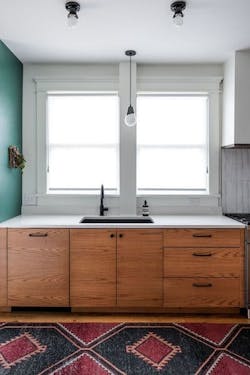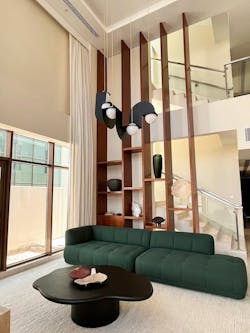MAREDI Design’s Multicultural Approach to Midwestern Style
Husband and wife duo Marc Jambert and Dijana Savic-Jambert call their journey to starting MAREDI Design a “natural evolution” that stemmed from years of studying and executing interior design in their own respective careers. Marc, who was born and raised in France, and Dijana, who was raised in the United States with a Serbian background, bring a multicultural perspective to the world of interior design to challenge the notions of what a space can actually do for its occupants.
Their ethos is simple: designing a home is like telling a story. And when it comes to their business model, their own story is fundamental to the way MAREDI Design serves its consumers, from France’s Loire Valley to the streets of the Windy City.
Custom Builder (CB): Can you talk about how splitting MAREDI Design between Europe and the U.S. influences your business model and your design strategy?
Dijana Savic-Jambert (DSJ): Chicago is more of a conservative design market, and we just really felt like we could push some of those boundaries by bringing more of a European-centric design approach across the pond. We’re introducing the market and our clients to brands and materials that they were previously unfamiliar with and showing them the possibilities of design from a different perspective.
CB: Can you talk about how and why European and U.S. styles play together and provide some examples from your projects?
DSJ: First and foremost, terrazzo has become more of a buzz in the U.S., but historically, it was used in ancient Italian homes and public places. It's a material that's been around for ages. Now it’s being executed really well by companies like Concrete Collaborative. We're also really focused on sustainable design with healthy materials, and Concrete Collaborative literally checks every box in terms of our criteria.
Another big element is plaster. It’s such a normal and natural choice in Europe, from finishing walls to furniture making, but it's a little bit more foreign in the U.S., particularly in the Midwestern market. That's been a fun one to reintroduce to those who are less familiar and explain to them some of its interesting properties and the ways that they can benefit from it.
Marc Jambert (MJ): We also like to challenge our clients when it comes to kitchens. In American design, kitchen staples are an island and a backsplash, but in this realm of sustainability, we try to limit the amount of materials we introduce into spaces. We’re adamant on introducing alternatives to our clients to offer up a different way of thinking about their spaces.
Our goal is to always be super intentional with not just each step of our process, but also with each design element. That may mean challenging our clients in terms of what their conditioning has been, whether they’re taking design inspiration from TV or magazines. We want to go beyond those conventions and standards.
Used historically in Italian architecture, terrazzo is becoming more popular across Europe and in the U.S.
Image: MAREDI Design
CB: Which style do you prefer and why?
MJ: I love Scandinavian style because it’s more minimalist than American design, where sometimes unnecessary elements are used to fill empty spaces. I actually prefer styles that aren’t afraid of empty space and also use a lot of natural materials.
DSJ: Minimalistic materials are big for us in terms of that sustainability aspect. To me, that leads to the concept of minimalistic design. In terms of intentionality, that makes sense. We don't necessarily go crazy on color, but we’re also not afraid of it. Again, as long as it’s intentional and it makes sense.
MAREDI Design takes a minimalist approach to classic European design staples with natural and sustainable materials
Image: MAREDI Design
CB: European design is heavily sought after in a lot of residential projects in the U.S., but is the reverse also the case in Europe? Are Europeans asking for design elements from America? If so, what are they most interested in?
MJ: French people are drawn towards the Californian boho style, especially in coastal cities and towns in southern France. A lot of designers in Europe sometimes try to incorporate that look into their projects.
DSJ: Another one that really sticks out is the “American-style” kitchen with an open concept layout, an island, and a large refrigerator. That’s something that can be requested pretty regularly in France and in Serbia, where my family is from.
CB: How do you feel that style is evolving around the industry and how are you meeting that evolution head-on?
DSJ: We have moved into a space of solely focusing on sustainable and regenerative design. We've completed several certifications as it pertains to the environment and designing homes more with the built environment in mind. That's definitely the topic that we’re bringing up more frequently with our clients. Some already have a bit of knowledge and interest and others have no idea. I would say that it still unfortunately leans more towards the latter.
Sustainability doesn't necessarily mean unaffordable, and it's about that education component for us. I would say that within our realm and on our radar, we are very much working to provide healthy and sustainable alternatives for literally any design category that you can think of.
MJ: One example of that is the induction cooktop. It’s standard in Europe, but not super common in the U.S. We’re hearing more clients asking about and wanting to understand its benefits.
Sustainability is definitely a larger global conversation in the niche space of design, and we’re hoping that more clients will meet us there versus the other way around. This is where the industry is headed and also where it should be going, and we will be an advocate for that all of the time.
This Dubai project by MAREDI Design mixes neutral elements with a pop of color
Image: MAREDI Design
CB: How is style evolving in Europe versus in the U.S.? Is it ever a challenge to balance your evolution as a company with two different continents and cultures that might be moving at two different speeds?
DSJ: It’s definitely challenging. Europe is more advanced in terms of design, from energy production and consumption to the materials they’re using. The U.S. is sometimes hyper-fixated on trying to find the next coolest thing, but in Europe, designers are sticking to standard, normal, natural methods, but they’re being executed more efficiently.
Something as simple and straightforward as Tadelakt plaster in Europe is rarely used in the U.S. In Europe, it’s super common and inexpensive, but in the U.S., there are few artisans who are trained to work with that type of plaster and it’s far more expensive. Differences in the design evolution from continent to continent are learning moments for us to take a pause, recalibrate, and assess what is realistic for us to bring from one place to another.
MJ: It’s also a lot about managing expectations. Our American clients who come to France have an image of what a provincial French home should look like, and we may have to redirect them and align their vision with reality rather than trying to design the dream home from their misconception.



